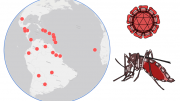Another year’s Beast Cancer Awareness Month is behind us. The Canadian and American Breast Cancer Foundations take the lead on the massive pink campaigns in October. Part of the campaign’s success is the phenomenal involvement within professional and amateur sports. Over the past few years it has become incredibly fashionable to wear pink in October. Pink skate laces, athletic tape, gloves, pom-poms, jerseys, towels, football penalty flags, and whistles are commonly purchased and used in game play.
At first blush, wearing pink shows a personal dedication to supporting people affected by cancer. A team or athlete taking the time to alter their equipment is a touching sign of solidarity.
Despite best intentions there is disconnect between the campaign to bring awareness and the people actually affected by cancer. Money spent on products is siphoned off towards production costs and profit, while the finances that do reach charities are limited in their reach when it comes to research and providing direct support for families and individuals affected by cancer.
Consider the fact that, according to an article from Business Insider in 2013, only five per cent of sales on NFL items that are on average marked up in price by 100 per cent go to the American Cancer Society. From there, the ACS only directs about 70 per cent of donated money towards research and outreach programs.
The fact that some money will end up in the purse of a reputable organization is fantastic, but the story doesn’t end there. Because of the way we’re approaching funding, corporations are given the agency to choose what issues in society are worth funding and which are not. Fighting cancer through consumerism chokes much-needed funding to a trickle. Again, a portion of the purchase goes to the retail outlet, a portion to manufacturing, a portion to transportation, and, finally, a portion to the charity. The money that reaches charity, including direct donations, is split between administrative and other operational costs before reaching the frontline battle with cancer.
People looking to fight against cancer should make donations directly to universities and not-for-profit organizations that are responsible for research and the provision of care. But there is no glory in good deeds if they can’t be worn.
Wearing pink is often as much a show of support as one of ego. While there is some value in showing collective support for people affected by cancer, wearing pink all too often redirects focus from the cause to the clothing. Placing the person or team investing in pink apparel ahead of people living with cancer, survivors, victims, and family and friends affected by this terrible disease – which we do when we purchase their pink products – warps the message into a shallow one.
Companies offering pink merchandise build goodwill with customers, increase sales with feel-good alternatives to existing products, and benefit from tax rebates for making charitable donations. Picking a cause becomes part of a corporation’s interest because it matters, financially speaking, for their bottom line.
Again, this is troubling because of the fact that corporations then play an increasingly larger role in what causes are worthy of support. Applying a free market approach to public health concerns is not in the public interest.
There is no need to rely on the concept of corporate social responsibility when it comes to major public health concerns. Corporate activity can be overcome by public funding directed toward research. Governments should have greater motivation to provide public funding for research in prevention, care, and cures for diseases, and they have the capacity to do so in ways corporations never will. Individuals looking to donate can take their money directly to frontline organizations rather than passing the buck to grant-giving charities, and they can feel secure in the knowledge that their money will generate a more substantial impact.
Of course, a sea of pink must leave positive feelings for some people battling cancer. Knowing that millions of strangers have your back may break some of the isolation cancer patients often feel. But when November comes and the pink is gone, cancer and the fight against it remain.




